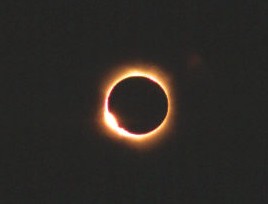| Total eclipse | |
 The diamond ring effect at the end of totality, taken near Woomera, South Australia | |
| Gamma | −0.302 |
|---|---|
| Magnitude | 1.0244 |
| Maximum eclipse | |
| Duration | 124 s (2 min 4 s) |
| Coordinates | 39°30′S59°36′E / 39.5°S 59.6°E |
| Max. width of band | 87 km (54 mi) |
| Times (UTC) | |
| Greatest eclipse | 7:32:16 |
| References | |
| Saros | 142 (22 of 72) |
| Catalog # (SE5000) | 9514 |
A total solar eclipse occurred at the Moon's descending node of orbit on Wednesday, December 4, 2002, [1] [2] [3] with a magnitude of 1.0244. A solar eclipse occurs when the Moon passes between Earth and the Sun, thereby totally or partly obscuring the image of the Sun for a viewer on Earth. A total solar eclipse occurs when the Moon's apparent diameter is larger than the Sun's, blocking all direct sunlight, turning day into darkness. Totality occurs in a narrow path across Earth's surface, with the partial solar eclipse visible over a surrounding region thousands of kilometres wide. Occurring about 1.9 days after perigee (on December 2, 2002, at 8:50 UTC), the Moon's apparent diameter was larger. [4]
Contents
- Observations
- Eclipse timing
- Places experiencing total eclipse
- Places experiencing partial eclipse
- Gallery
- Eclipse details
- Eclipse season
- Related eclipses
- Eclipses in 2002
- Metonic
- Tzolkinex
- Half-Saros
- Tritos
- Solar Saros 142
- Inex
- Triad
- Solar eclipses of 2000–2003
- Saros 142
- Metonic series
- Tritos series
- Inex series
- Notes
- References
The eclipse was visible from a narrow corridor in parts of Angola, Botswana, Zimbabwe, South Africa, Mozambique, the Indian Ocean and South Australia. A partial eclipse was seen from the much broader path of the Moon's penumbra, including most of Africa and Australia in addition to parts of Indonesia and Antarctica. During the sunset after the eclipse many observers in Australia saw numerous and unusual forms of a green flash. [5]
In some parts of Angola, it was the second total eclipse of the Sun within 18 months, following the solar eclipse of June 21, 2001.














































































































